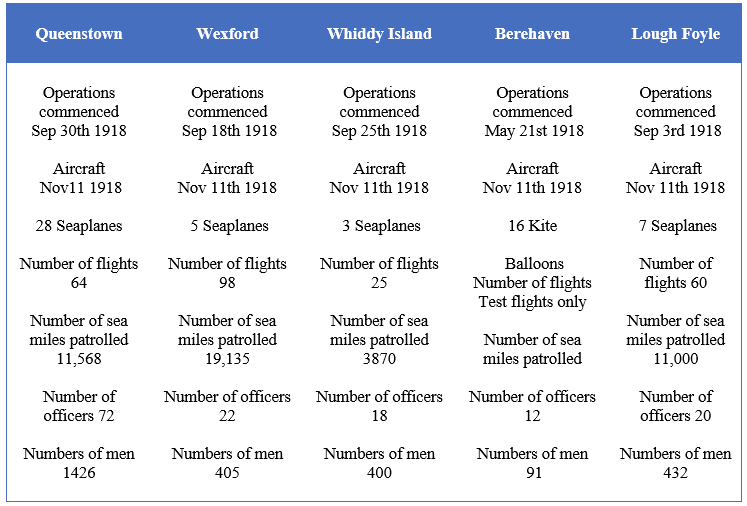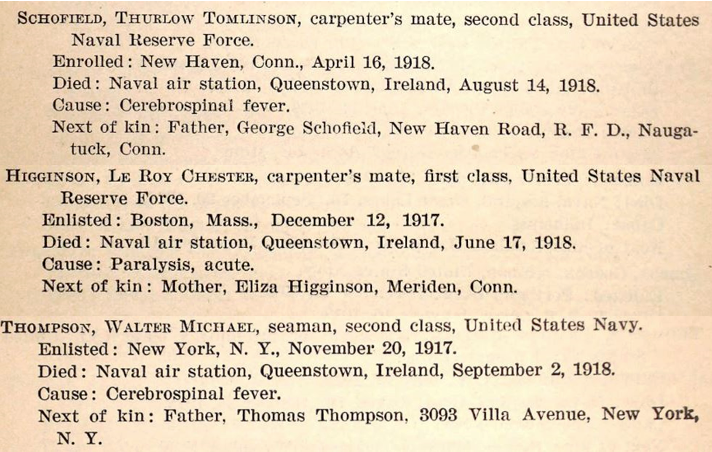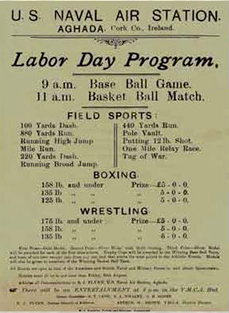The Americans in Aghada

‘American naval aviation had a romantic beginning; indeed, the development of our air service from nothing to a force which, in European waters, comprised 2,500 officers and 22,000 men, is one of the greatest accomplishments of the war.’
Woodrow Wilson declared war on the Germans on 6 April 1917. It was with reluctance as he was an advocate of neutrality and tried to avoid going to war. The American situation was that it was unprepared for the might of the European armies. The US Navy had bases in mainland Europe and the British Isles in an attempt to combat the U-Boat menace, including the first base at Queenstown (Cobh) in Ireland. The Americans had a total of seven naval aviation stations on the British Isles, including five in Ireland. These were located at Queenstown (Aghada), Wexford, Lough Foyle, Whiddy Island, and Berehaven. These five units came under the command of Commander F. McCrary, United States Navy who took command on 14 February 1918 and remained in command throughout the war. The sites for these stations were selected at the request of the British Admiralty and commandeered under the ‘Defence of the Realm’ Act.

Site A at the water’s edge is the American airbase. This included 6 hangers, concrete apron, slipway, pier, maintenance sheds, assembly sheds, wireless installation, pigeon loft and storage sheds. Saobhran Cottage, close to the hangers and Aghada Hall, was taken over by the Americans as part of its administration and headquarters. A new road was built inland to enlarge the site.
Site B, taken over by U.S.N.A.S, for living quarters for the enlisted men and ancillary works, was known as ‘Timber Town’. These were timber huts situated in Upper Aghada, a self-containing British Army camp made up of two separate camps, known as East Camp and West Camp and were able to accommodate over two thousand men. Along with accommodation many other facilities existed, which included a hospital, bath house and ablution block, latrines, drying room, quartermaster’s stores, stables, harness room, forage store, dung pit, vehicle shed, electricity plant, coal yard, destruction shed, disinfector shed, rifle range, a revolver range and a playground. In the camps wooden huts generally accommodated thirty men. Just outside these camps was the YMCA building.

The Aghada base, under the command of Lt. Cmdr. Paul J. Peyton, was not only an operational flying boat base, but also used for the assembling and testing of the flying boats and a training station for pilots within the Irish units. Included in the construction of the Aghada base were a number of large hangers, a large concrete apron and a slipway down into the sea, a pier, maintenance sheds, assembly sheds, wireless installation, pigeon loft, storage sheds and a number of roads. The company that carried out the construction was Moran & Company and their Chief Assistant Engineer for this project was John Joseph Murphy. A number of buildings were commandeered to house the officers, Aghada Hall for the station officers and Sobroan cottage to house the headquarter staff. The remaining men were housed in Aghada camp. The area of operation for the seaplanes from Aghada covered from Cape Clear in the west, to the convoy channels to the east on the routes to France in the St Georges Channel.

Construction Work U.S.N.A.S Aghada
Curtiss H-16, nicknamed ‘Large America’ was the type of sea plane based at Aghada. They were constructed at Buffalo, New York, dismantled, boxed away in crates and shipped to Ireland and rebuilt and tested in Aghada. The first shipment, a total of eight planes, arrived on the USS Guyana, Queenstown 27 June 1918 followed by another shipment of ten planes on 3 August 1918 by the USS Kanawha and ferried across to Aghada for construction.

U.S.N.A.S Situation 11 Nov 1918, ReoCities, “United States Naval Air Service in Ireland” in United States Naval Air Service in Ireland
‘In November 1918, as the world struggled with the growing influenza pandemic, Germany collapsed. Peace was declared on 11 November. Nine million people, 340,000 of them Americans, had died during the war. Horrific as this number was, it would be dwarfed by the fifty million who would die in the influenza pandemic.’
The United States Naval Air Station in Aghada was struck with the flu epidemic which began in July 1918 with cases being reported up until November of the same year. A total of 243 were affected. U.S.S. Dixie stationed at Queenstown had 11 per cent of their crew affected, a total of seventy cases. During this period the American Airbase in Aghada suffered three casualties.

Extracts from U.S. Navy Casualties Books, 1776-1941
‘In 1918, Navy and Marine patients totalling 121,225 were admitted at Navy medical facilities with influenza. Of these patients, 4,158 died of the virus and sick patients spent over one million sick days in these facilities worldwide.’
On a lighter note, events held at the sea plane base were the Labor Day events, which included a baseball game, a basketball game, athletics, boxing and wrestling. After the Armistice there was no further need for the airbase so it closed on 10 April 1919.
 Handbill Advertising U.S.N.A.S Sports Day, ReoCities, ‘United States Naval Air Service in Ireland’
Handbill Advertising U.S.N.A.S Sports Day, ReoCities, ‘United States Naval Air Service in Ireland’
Fixtures and fittings were sold off to businesses and individuals. Part of the base can still be seen, including the concrete apron and slipway, as well as some of the red brick administration buildings and the nearby Yankee pier. The air-base gate pillars are still standing today. The road, known as the Yankee Hill gets its name from the American personnel at the air base.

Sale of Buildings, Irish Examiner, 2 August 1919

Curtiss H-16 flying boat on the ramp, circa 1918 at Naval Air Station, Aghada below picture of ramp taken 28 March 2016 by Author


Remaining gateposts to U.S.N.A.S Airbase Lower Aghada Co. Cork